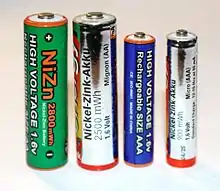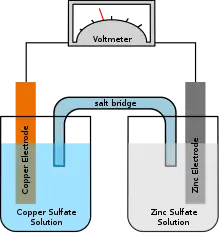Nickel–zinc battery
A nickel–zinc battery, abbreviated NiZn, is a type of rechargeable battery similar to NiCd batteries, but with a higher voltage of 1.6 V.
 Nickel–zinc cells in AA and AAA sizes | |
| Specific energy | 100 W·h/kg |
|---|---|
| Energy density | 280 W·h/L |
| Specific power | > 3000 W/kg |
| Energy/consumer-price | 2–3Wh/US$ |
| Nominal cell voltage | 1.65 V |
Larger nickel–zinc battery systems have been known for over 100 years. Since 2000, development of a stabilized zinc electrode system has made this technology viable and competitive with other commercially available rechargeable battery systems. Unlike some other technologies, trickle charging is not recommended.
History
In 1901 Thomas Alva Edison was awarded U.S. Patent 684,204 for a rechargeable nickel–zinc battery system.[1]
The battery was later developed by the Irish chemist Dr. James J. Drumm (1897–1974),[2] and installed in four two-car Drumm railcar sets between 1932 and 1949 for use on the Dublin–Bray railway line. Although successful, they were withdrawn when the batteries wore out. Early nickel–zinc batteries provided only a small number of discharge/recharge cycles. In the 1960s nickel–zinc batteries were investigated as an alternative to silver–zinc batteries for military applications, and in the 1970s were again of interest for electric vehicles.[3] Evercel Inc. developed and patented several improvements in nickel–zinc batteries, but withdrew from that area in 2004.[4]
Applications
Nickel–zinc batteries have a charge/discharge curve similar to 1.2 V NiCd or NiMH cells, but with a higher 1.6 V nominal voltage.[5]
Nickel–zinc batteries perform well in high-drain applications, and may have the potential to replace lead–acid batteries because of their higher energy-to-mass ratio and higher power-to-mass ratio — as little as 25% of the mass for the same power.[6] NiZn are cheaper than nickel-cadmium batteries,[6] and are expected to be priced somewhere between NiCd and lead–acid types. NiZn may be used as a substitute for nickel–cadmium. The European Parliament has supported bans on cadmium-based batteries;[1] nickel–zinc is a good alternative for power tools and other applications. A disadvantage is increased self-discharge rate after about 30-50 cycles, so that batteries do not hold their charge as long as when new. Where this is not a problem NiZn is a good battery choice for applications requiring high-power and high-voltage.[7]
Battery life
Compared with cadmium hydroxide, the tendency of the soluble zinc hydroxide ion (zincate) to dissolve into solution and not fully migrate back to the cathode during recharging has, in the past, presented challenges for the commercial viability of the NiZn battery.[1][3] Another common issue with zinc rechargeable batteries is electrode shape change and dendrites (or "whiskers"), which may reduce the cell discharging performance or, eventually, short out the cell, resulting in a low cycle life.
Recent advances have enabled this problem to be greatly reduced. These advances include improvements in electrode separator materials, inclusion of zinc material stabilizers, and electrolyte improvements (e.g. by using phosphates). PowerGenix has developed 1.6 V batteries with claimed battery cycle life comparable to NiCd batteries.[8]
Battery cycle life is most commonly specified at a discharge depth of 80 percent of rated capacity and assuming a one-hour discharge current rate. As the discharge current or the depth of discharge is reduced, the number of charge-discharge cycles for a battery increases. When comparing NiZn to other battery technologies, cycle life comparisons may vary depending on the discharge rate and depth of discharge used.
Advantages
Nickel–zinc cells have an open circuit voltage of 1.85 volts when fully charged,[9] and a nominal voltage of 1.65 V. This makes NiZn an excellent replacement for electronic products designed to use 1.5 V alkaline primary cells. Equipment designed for alkaline batteries will not operate properly below an endpoint voltage based on 1.5 V when fresh; NiCd and NiMH both have nominal cell voltages of 1.2 V, and will reach this endpoint before their charge capacity is fully depleted.
Newer cells which are more powerful and with a life of up to 800 cycles can be an alternative to Li-ion batteries for electric vehicles. Due to the higher cell voltage, fewer cells are required for a given pack voltage than for NiCd and NiMH. They also have low internal impedance (typically 5 milliohms), which allows for high battery discharge rates, up to 50C. (C is battery capacity in Ah, divided by one hour.)
NiZn batteries do not use mercury, lead, or cadmium, or metal hydrides, all of which can be difficult to recycle.[10] Both nickel and zinc are commonly occurring elements in nature, and can be fully recycled.
NiZn cells use no flammable active materials or organic electrolytes, and the newest models use polymeric separators which reduce the dendrites problem.
Properly designed NiZn cells can have very high power density and low-temperature discharging performance, and also can be discharged to almost 100%, and recharged without problems. As of 2017 they were available in sizes up to F, and 50Ah/ prismatic cell.
Zinc is a cheap and abundant metal, the 24th most abundant element in the Earth's crust, and is not dangerous to health. Common oxidation is +2, so charge and discharge move two electrons instead of one as in NiMH batteries.
Charging
Chargers for NiZn batteries must be capable of charging a battery with a fully charged voltage of 1.85 V per cell, higher than the 1.4 V of NiMH. NiZn technology is well suited for fast recharge cycling, as optimum charge rates of C or C/2 are preferred.[11]
Known charging regimes include a constant current of C or C/2 to cell voltage = 1.9 V. One manufacturer [12] recommends charging at a constant current of C/4 to C until cell voltage reaches 1.9V, then continuing to charge at a constant voltage of 1.9V until charge current declines to C/40.
Maximum charge time is given variously as 2 1⁄2 hours[11] and 3 hours.[13] Once charged, continuous trickle charging is not recommended, as recombination is not provided for, and excess hydrogen will eventually vent, adversely affecting battery cycle life. A typical charger for NiZn batteries specifically does not trickle charge after the battery is fully charged, but shuts off.[14]
Chemistry
- (−) electrode: Zn + 4 OH− ⇌ Zn(OH)42− + 2e− (E0 = −1.2 V/SHE )
- Electrolyte: KOH
- Zn(OH)42− ⇌ Zn(OH)2 + 2OH−
- Zn(OH)2 ⇌ ZnO + H2O
- (+) electrode: 2 NiO(OH) + 2 H2O + 2 e− ⇌ 2 Ni(OH)2 + 2 OH− (E0 = +0.50 V/SHE)
- Overall reaction: Zn + 2 NiO(OH) + H2O ⇌ ZnO + 2 Ni(OH)2
- Parasitic reaction: Zn + 2 H2O → Zn(OH)2 + H2
See also
- Comparison of battery types
- List of battery sizes
- List of battery types
- Nickel–cadmium battery
- Zinc–air battery
References
- "Building A Better Battery", Kerry A. Dolan, Forbes.com, Forbes magazine, 11 May 2009, accessed 2011-02-12, Forbes-44.
- "Famous Irish Chemists: James J. Drumm". Ul.ie. Archived from the original on 22 July 2012. Retrieved 1 July 2012.
- David Linden (ed)., Handbook of Batteries, McGraw Hill, 2002, ISBN 0-07-135978-8, chapter 31.
- Evercel financial statement 2007 Archived 7 March 2016 at the Wayback Machine, Evercel.com, page 9, retrieved 23 November 2010.
- Battery-meter-problem, NiZn discharge curves and camera voltage cutoffs, PentaxForums.com
- "Nickel Zinc". EnerSys.com. EnerSys. Retrieved 13 July 2015.
- Thomas, Justin (16 March 2012). "A Review Of NiZn Batteries". MetaEfficient.com. inSync Theme. Retrieved 10 August 2020.
- "A Brief History of Battery Developments", PowerGenix.com, 2010, retrieved 12 February 2011. Archived 25 February 2011 at the Wayback Machine
- New NiZn batteries offer lightning-fast recycle
- "Safety Data Sheet: Nickel Zinc Battery (Cell) Sizes: Sub-C and Prismatic". ZincFive. 24 May 2019. Retrieved 10 August 2020.
- "PowerGenix AA Battery Specifications" (PDF). Archived from the original (PDF) on 15 February 2010. Retrieved 1 July 2012.
- "Nickel-Zinc Charging Instructions". Zincfive. Retrieved 5 June 2019.
- "PowerGenix NiZn Quick Charger". Powergenix.com. Archived from the original on 23 April 2016. Retrieved 1 July 2012.
- "UPStealth NEMA Battery Panel". — ZincFive (formerly PowerGenix). 2017. Retrieved 23 January 2017.
